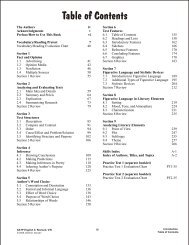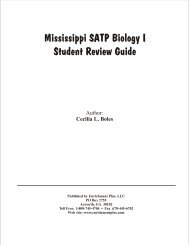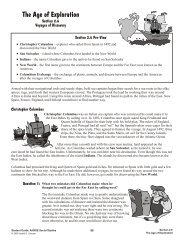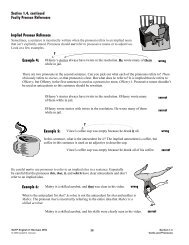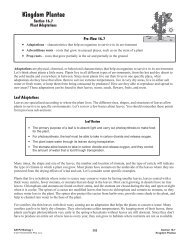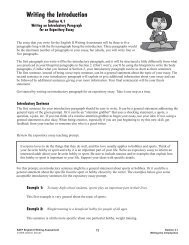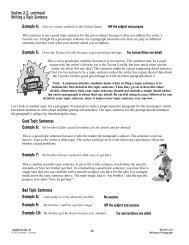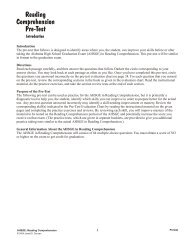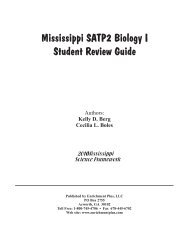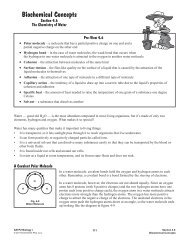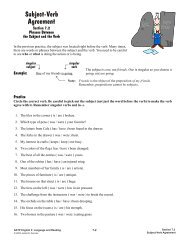Classification of Organisms - Enrichment Plus
Classification of Organisms - Enrichment Plus
Classification of Organisms - Enrichment Plus
You also want an ePaper? Increase the reach of your titles
YUMPU automatically turns print PDFs into web optimized ePapers that Google loves.
<strong>Classification</strong> <strong>of</strong><br />
<strong>Organisms</strong><br />
Section 13.3<br />
The Six Kingdoms<br />
Pre-View 13.3<br />
Five Kingdom System – classification system that includes Animalia, Plantae, Fungi,<br />
Protista, and Monera<br />
Six Kingdom System – classification system that includes Animalia, Plantae, Fungi, Protista, Eubacteria,<br />
and Archaebacteria<br />
Archaebacteria – newest kingdom that includes organisms that look like bacteria but have different<br />
characteristics than “normal” bacteria<br />
Eubacteria – typical bacteria that were classified as Monera in the five kingdom system<br />
Prokaryotic – describes the cell <strong>of</strong> single-celled organisms where the cell does not have a true nucleus<br />
Eukaryotic – describes the cells <strong>of</strong> organisms where each cell generally has a nucleus and other<br />
membrane-bound organelles (Mature red blood cells in mammals are eukaryotic, but they do not contain a<br />
nucleus.)<br />
Autotrophic – describes organisms that make their own food<br />
Heterotrophic – describes organisms that cannot make their own food<br />
When Aristotle first began to classify organisms, he divided them into two main kingdoms, plants and animals. You<br />
are probably most familiar with these two kingdoms. As scientists began using microscopes, they discovered<br />
microscopic organisms. They also discovered differences in cell structure between different organisms. They<br />
discovered that some organisms have characteristics that make it difficult to classify them as either plant or animal.<br />
Two kingdoms no longer worked, and eventually they decided on a five kingdom system: Animalia, Plantae, Fungi,<br />
Protista, and Monera.<br />
These five kingdoms stuck around for a while, and many people still think in terms <strong>of</strong> these five kingdoms. However,<br />
more recently, something else interesting happened. With the new technology that became available, scientists<br />
discovered that some bacteria have different gene sequences than any other organism living on earth. This discovery<br />
led to the formation <strong>of</strong> a new kingdom called the archaebacteria, or “ancient bacteria.” In addition to having<br />
different gene sequences, these bacteria also have chemical specializations in their cell walls, and they live in the most<br />
extreme conditions. All other bacteria were placed in the kingdom Eubacteria. So, now most scientists commonly use<br />
a six kingdom system for classification: Animalia, Plantae, Fungi, Protista, Eubacteria, and Archaebacteria. (Not to<br />
confuse the point, but some scientists classify the six kingdoms into three main “domains,” with a domain being a<br />
taxon above kingdom. As we continue to learn more and more, these classification systems may very well change<br />
again!)<br />
The Six Kingdoms<br />
• Archaebacteria (newest kingdom) – organisms that resemble bacteria but that live in extreme conditions<br />
• Eubacteria (known as the Monera kingdom in the five kingdom system) – typical bacteria<br />
• Protista – examples are algae, protozoa, slime molds<br />
• Fungi – examples are molds, mushrooms, yeasts<br />
• Plantae – examples are mosses, ferns, grasses, vegetable plants, trees<br />
• Animalia – examples are sponges, jellyfish, worms, snails, insects, fish, frogs, lizards, birds, kangaroos<br />
AHSGE: Biology<br />
© 2008 Jerald D. Duncan<br />
247<br />
Section 13.3<br />
<strong>Classification</strong> <strong>of</strong> <strong>Organisms</strong>
Section 13.3, continued<br />
The Six Kingdoms<br />
Remember that a kingdom is the largest classification group. <strong>Organisms</strong> in each kingdom share many cellular<br />
characteristics. For example, are the organisms unicellular or multicellular? Are the organisms’ cells prokaryotic (no<br />
membrane bound organelles) or eukaryotic (have membrane bound organelles)?<br />
Do the cells have a cell wall? If so,<br />
what is it made <strong>of</strong>? Does the organism make its own food (autotrophic) or must it obtain food (heterotrophic)? Note<br />
that organisms that make their own food usually have chloroplasts in their cells, which enable them to carry out<br />
photosynthesis. Only a few types <strong>of</strong> organisms can make their own food without chloroplasts, and those are the ones<br />
that undergo chemosynthesis instead <strong>of</strong> photosynthesis. The chart below shows these main cellular characteristics for<br />
organisms in the six kingdoms.<br />
Kingdom Type <strong>of</strong> cells Nucleus? Cell Wall? Makes Its Own Food?<br />
Archaebacteria<br />
(or Archae)<br />
Unicellular<br />
No<br />
Yes,<br />
but not made <strong>of</strong><br />
peptidogylcan<br />
Some do,<br />
mostly by chemosynthesis<br />
Eubacteria<br />
(Monera)<br />
Unicellular<br />
No<br />
Most do,<br />
usually made <strong>of</strong><br />
peptidoglycan<br />
Some do,<br />
mostly by photosynthesis<br />
Protista<br />
Unicellular or<br />
Multicellular<br />
Yes<br />
Some do,<br />
mostly made<br />
<strong>of</strong> cellulose<br />
Some do<br />
by photosynthesis<br />
Fungi<br />
Unicellular or<br />
Multicellular<br />
Yes<br />
Yes,<br />
made <strong>of</strong> chitin<br />
and cellulose<br />
No<br />
Plantae Multicellular Yes<br />
Yes,<br />
made <strong>of</strong> cellulose<br />
Yes,<br />
by photosynthesis<br />
Animalia Multicellular Yes No No<br />
Practice 1<br />
For each organism described, choose the MOST likely kingdom that the organism belongs to. Each kingdom<br />
will only be used once.<br />
________ 1. a prokaryotic, unicellular organism that contains chloroplasts<br />
________ 2. a eukaryotic, unicellular organism that contains chloroplasts<br />
________ 3. a multicellular organism whose cells do not have a cell wall<br />
________ 4. a multicellular organism that has a cell wall but does not make its<br />
own food<br />
________ 5. a multicellular organism the makes its own food using photosynthesis<br />
________ 6. a unicellular organism that lives in complete darkness deep on the<br />
ocean floor near a volcanic vent<br />
A. Archaebacteria<br />
B. Eubacteria<br />
C. Protista<br />
D. Fungi<br />
E. Plantae<br />
F. Animalia<br />
AHSGE: Biology 248<br />
Section 13.3<br />
© 2008 Jerald D. Duncan<br />
<strong>Classification</strong> <strong>of</strong> <strong>Organisms</strong>



